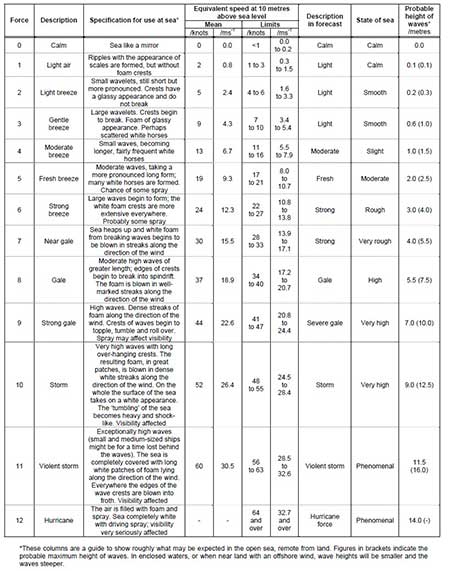Beaufort Wind Scale: A Closer Look
For a larger version of the Beaufort Scale click here.
The Beaufort Wind Scale is a scale that is used by seamen and coastal observers to estimate wind speed. The scale was created by British Rear Admiral Sir Francis Beaufort in the year 1805, and it was derived from his observations of sea conditions. It was especially important during the 19th century, because no sophisticated wind speed-measuring equipment was available at that time. Despite the introduction of new technologies, it is still being used by seafarers today, and it also applied to measure wind speed on land.
Initially, the Beaufort Wind Scale has 13 classes, which were numbered 0 to 12, to provide descriptions for various wind conditions. It was only in 1955 that the scale was extended to include five more classes, numbers 13 to 17. The present scale also includes descriptions of the effects of wind forces on land. The modern Beaufort Wind Scale consists of six columns, which include Beaufort Number, Description, Wind Speed, Wave Height, Sea Conditions, and Land Conditions. In some cases, extra columns are added to the scale to provide descriptions of coast conditions and the performances of ships in the sea.
When the Beaufort number is 1, it means that the condition of the sea is very calm, and there is almost no wind at all. The speed of the wind is less than 1 mile per hour, and the surface of the sea is flat. On land, smoke will rise vertically. When a breeze occurs, it can range from a light breeze, which is represented by number 3, to a strong breeze, which is number 6. At number 6, the wind speed measures 25 to 30 miles per hour, and the wave height is 9 to 13 feet. There will be frequent foam crests and long waves forming at sea. A gale is represented by numbers 7 to 10 on the Beaufort Wind Scale, with number 10 indicating a whole gale or a storm. A whole gale usually has a wind speed of 55 to 63 miles per hour, and waves can rise to as high as 55 feet. With the formation of huge patches of foam from high waves, parts of the surface of the sea will become white. Visibility will be significantly reduced because of increased airborne spray. When the Beaufort number reaches 12, a hurricane is taking place. The wind will be moving at a speed of more than 73 miles per hour, and huge waves of 46 feet or higher will occur. The sea will be completely covered with foam, and driving airborne spray makes visibility almost impossible.
| Force | Wind (Knots) |
WMO Classification |
Appearance of Wind Effects | ||
|---|---|---|---|---|---|
| On the Water | On Land | ||||
| 0 | Less than 1 | Calm | Sea surface smooth and mirror-like | Calm, smoke rises vertically | |
| 1 | 1-3 | Light Air | Scaly ripples, no foam crests | Smoke drift indicates wind direction, still wind vanes | |
| 2 | 4-6 | Light Breeze | Small wavelets, crests glassy, no breaking | Wind felt on face, leaves rustle, vanes begin to move | |
| 3 | 7-10 | Gentle Breeze | Large wavelets, crests begin to break, scattered whitecaps | Leaves and small twigs constantly moving, light flags extended | |
| 4 | 11-16 | Moderate Breeze | Small waves 1-4 ft. becoming longer, numerous whitecaps | Dust, leaves, and loose paper lifted, small tree branches move | |
| 5 | 17-21 | Fresh Breeze | Moderate waves 4-8 ft taking longer form, many whitecaps, some spray | Small trees in leaf begin to sway | |
| 6 | 22-27 | Strong Breeze | Larger waves 8-13 ft, whitecaps common, more spray | Larger tree branches moving, whistling in wires | |
| 7 | 28-33 | Near Gale | Sea heaps up, waves 13-19 ft, white foam streaks off breakers | Whole trees moving, resistance felt walking against wind | |
| 8 | 34-40 | Gale | Moderately high (18-25 ft) waves of greater length, edges of crests begin to break into spindrift, foam blown in streaks | Twigs breaking off trees, generally impedes progress | |
| 9 | 41-47 | Strong Gale | High waves (23-32 ft), sea begins to roll, dense streaks of foam, spray may reduce visibility | Slight structural damage occurs, slate blows off roofs | |
| 10 | 48-55 | Storm | Very high waves (29-41 ft) with overhanging crests, sea white with densely blown foam, heavy rolling, lowered visibility | Seldom experienced on land, trees broken or uprooted, "considerable structural damage" | |
| 11 | 56-63 | Violent Storm | Exceptionally high (37-52 ft) waves, foam patches cover sea, visibility more reduced | ||
| 12 | 64+ | Hurricane | Air filled with foam, waves over 45 ft, sea completely white with driving spray, visibility greatly reduced | ||
The information provided by the Beaufort Wind Scale is very useful to seafarers, because it can help them manage their ships more efficiently and take measures to counter adverse sea conditions. They will know which sails to use to take full advantage of the wind to reach their destinations in the shortest time possible. Also, they can reduce sails when there is a storm at sea. Some Beaufort Wind Scales include sailing instructions for seafarers to deal with each type of wind force in his original scale, and these have helped many seamen achieve safe and efficient voyages.
